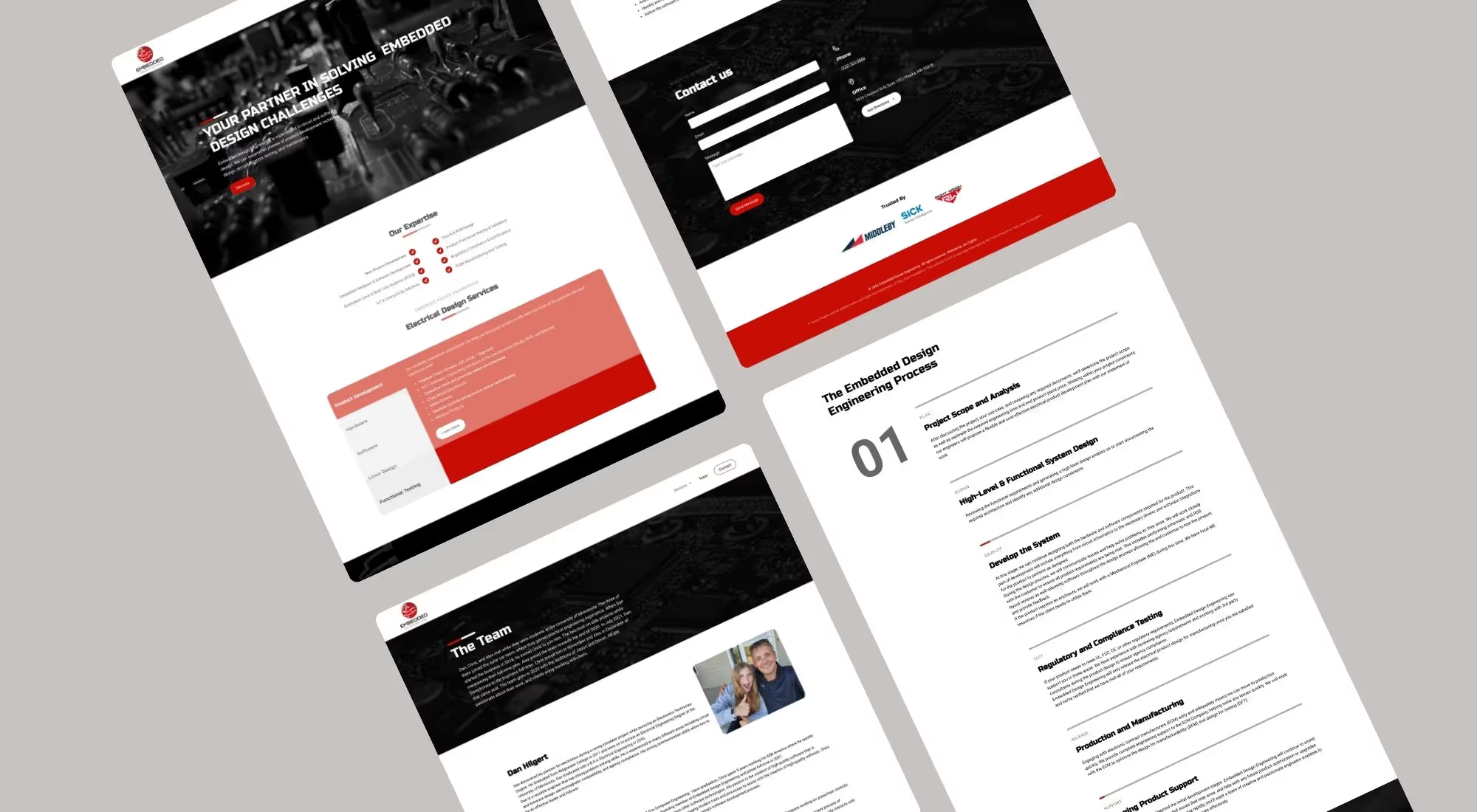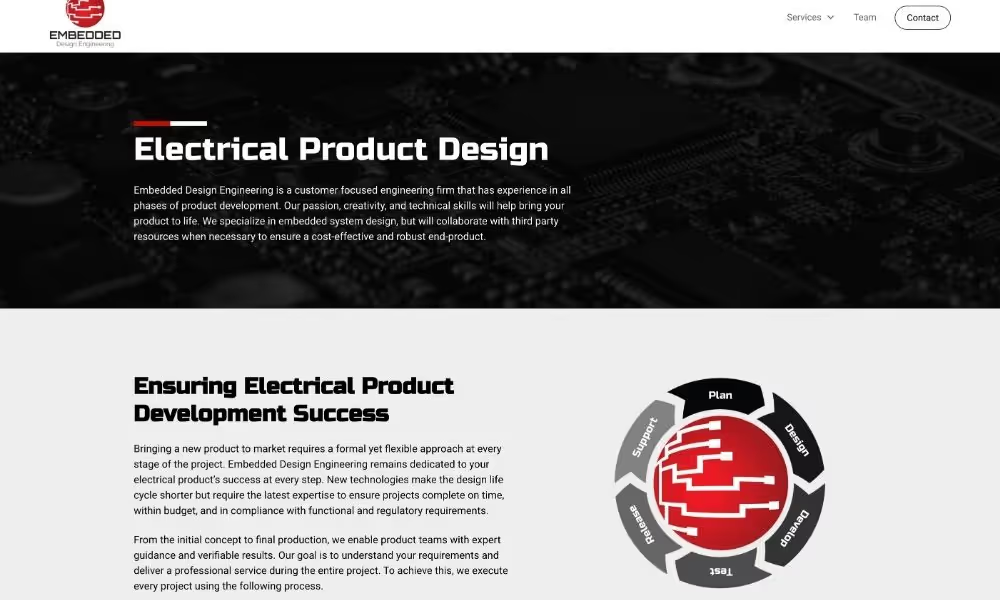
Embedded Designs
Integrated Hardware and Software Excellence: Embedded Design Engineering's Comprehensive Approach
The Embedded Design Engineering (EEMN) website represents a masterful integration of technical expertise and clear communication design. This case study explores how the platform effectively showcases EEMN's specialized embedded systems capabilities through thoughtful information architecture, technical depth, and client-focused presentation that positions them as Minnesota's premier embedded systems partner.
Project Background and Objectives
Embedded Design Engineering (EEMN) approached the development team with a clear vision: to create a digital platform that would effectively communicate their specialized technical expertise while establishing them as Minnesota's premier embedded systems partner. As a company founded in 2018 with deep experience in circuit and software design, EEMN needed a website that would not only showcase their comprehensive service offerings but also convey their technical credibility to potential clients.
The project began with several key objectives:
Technical Expertise Showcase: Develop a platform that clearly articulates EEMN's specialized capabilities across hardware design, software development, embedded Linux, and functional testing in a way that resonates with technically sophisticated clients.
Service Clarity: Create a structured presentation of services that helps potential clients quickly understand EEMN's comprehensive capabilities and how they align with specific project needs.
Credibility Establishment: Integrate authentic client testimonials and detailed technical information to establish EEMN as a trusted partner for complex embedded systems projects.
Minnesota Identity: Position EEMN as a local Minnesota-based resource with global capabilities, emphasizing their accessibility and regional presence.
Team Introduction: Present the EEMN team as experienced professionals with deep technical knowledge and a collaborative approach to client relationships.
These objectives guided both the information architecture and visual design decisions throughout the project, ensuring that the final website would effectively serve as both a marketing tool and a technical resource for potential clients.

Design Strategy: Technical Clarity with Visual Impact
The design strategy for the EEMN website focused on creating a digital experience that would effectively communicate complex technical information while maintaining visual engagement:
Visual Identity Elements
The site's visual identity was crafted to reflect EEMN's technical precision and expertise:
Color System ImplementationThe website employs a strategic color system that enhances both readability and brand recognition:
- Bold Red Accent: The primary red color serves as both a brand identifier and a visual guide, drawing attention to key service areas and call-to-action elements throughout the site.
- Neutral Background Palette: Light neutral backgrounds for service category tabs create clear visual separation between content sections while maintaining a clean, professional aesthetic.
- High-Contrast Typography: Dark text on light backgrounds ensures optimal readability for technical content, respecting the needs of the engineering audience.
Typography and LayoutThe typographic approach prioritizes clarity and information hierarchy:
- Bold Headlines: Strong, impactful headlines clearly delineate major sections and service categories, creating immediate visual understanding of content organization.
- Readable Technical Content: Body text is optimized for readability, acknowledging that technical specifications and service descriptions require careful attention from visitors.
- Whitespace Utilization: Strategic use of whitespace around content elements creates breathing room that enhances focus on complex technical information.
- Grid-Based Organization: The service presentation employs a clear grid system that creates visual order, reflecting the systematic thinking valued in engineering disciplines.
These design elements work together to create a visually cohesive experience that reinforces EEMN's identity as a precise, technically sophisticated organization.
Content Presentation
The content structure was carefully designed to maximize technical clarity:
Service Categorization The service presentation system employs a thoughtful categorization approach:
- Primary Service Pillars: Services are organized into five clear categories (Product Development, Hardware, Software, Linux Design, and Functional Testing) that align with how clients typically conceptualize embedded systems projects.
- Visual Tab Interface: The tab-based navigation system allows visitors to quickly switch between service categories without losing context or requiring page reloads.
- Consistent Format: Each service category maintains a consistent presentation format, helping visitors quickly locate and compare specific capabilities across categories.
- Capability Highlighting: Bullet-point presentations of specific capabilities within each service category allow for quick scanning while providing sufficient technical detail.
This thoughtful organization ensures that content is not only accessible but presented in a way that builds credibility with technically sophisticated visitors.
The technical implementation of the EEMN website focused on creating a platform that would effectively communicate complex technical information while providing an intuitive user experience:
Webflow Implementation
The website leverages Webflow's capabilities to create a responsive, professional experience:
Component-Based ArchitectureThe site structure employs a modular approach for consistency and maintainability:
- Reusable Service Components: Each service category utilizes consistent component structures, allowing for unified presentation while accommodating varying content needs.
- Responsive Grid System: The implementation uses Webflow's grid system to ensure proper alignment and spacing across all device sizes, maintaining readability of technical content on mobile devices.
- Custom Tab Interaction: The service tabs employ custom interactions that maintain state and provide visual feedback, enhancing the user experience when exploring different service categories.
Client First MethodologyThe implementation follows Client First best practices for optimal performance and maintainability:
- Semantic Class Naming: The class naming convention follows a logical, semantic structure that enhances development efficiency and future maintainability.
- Clean Code Structure: The underlying code maintains a clean, organized structure that facilitates future updates and expansions.
- Performance Optimization: Page speed optimization techniques ensure that the technical content loads quickly, respecting visitors' time and improving search engine performance.
These technical decisions create a foundation that balances visual sophistication with technical performance, reflecting EEMN's own engineering values.

Relume and Finsweet Integration
The site leverages specialized Webflow tools to enhance functionality:
Relume Library Components The design implementation utilizes Relume components for enhanced visual consistency:
- Consistent UI Elements: Buttons, cards, and navigation elements maintain visual consistency through Relume component usage.
- Design System Integration: The implementation leverages Relume's design system capabilities to maintain color, typography, and spacing consistency throughout the site.
Finsweet Functionality Enhancement The implementation incorporates Finsweet tools for enhanced user experience:
This thoughtful integration of specialized Webflow tools creates a technical implementation that is both visually sophisticated and functionally robust.
Conclusion
The EEMN website demonstrates how thoughtful design and technical implementation can effectively communicate specialized expertise to a sophisticated audience. By combining clear information architecture, detailed technical content, and strategic visual design, the implementation created a platform that successfully positions Embedded Design Engineering as Minnesota's premier embedded systems partner.
The EEMN website succeeds by recognizing that in specialized technical fields, digital platforms serve dual purposes—they must function as both marketing tools and technical resources. Through careful attention to content organization, technical accuracy, and user experience design, the implementation creates a digital presence that authentically represents EEMN's capabilities and supports their business development goals.

